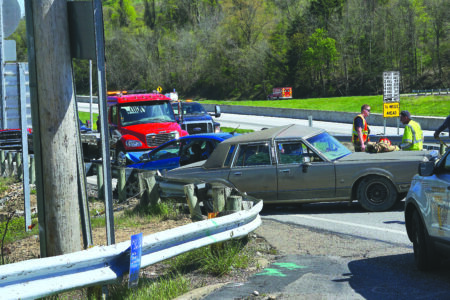Responders review procedures after leaks

ST. CLAIRSVILLE — The two recent leaks at St. Clairsville’s wastewater treatment plant offered an opportunity for officials to review their procedures to determine what went well and where there might be room for improvement.
City officials, representatives of the Cumberland Trail Fire District, the Belmont County Hazmat Response Team, and Belmont County 911 met Tuesday to do just that. While they pointed out the responses to both instances were successful, Cumberland Trail Assistant Fire Chief Tim Hall said the response to the second alarm in the Aug. 14 chlorine leak was more streamlined, with all the plant employees accounted for in order to determine if they had been exposed to hazardous materials.
St. Clairsville Service and Safety Director James Zucal noted that some of the six employees had left the area before being checked during the first incident, a sulfur dioxide leak on Aug. 4.
“We had mixed responses,” Hall said, mentioning some initial conflicting reports regarding whether or not employees had been exposed during the first incident. “At the time, we didn’t know if those employees had already left and if they’d been exposed or not.”
During the second incident a rally point had been established for the employees.
St. Clairsville Mayor Terry Pugh also said the lines of communication were clearer during the second event, with designated points of contact known and consulted so he could get accurate information quickly.
“I think we all learned a lot in 10 days,” Pugh said.
Hall also thanked St. Clairsville Police Chief Jeff Henry for the quick action of the police in assisting with response and evacuation.
“They’re the boots on the ground,” Hall said.
Henry also pointed out several deputies from the sheriff’s office were on hand. Tony Gregor, supervisor at the county 911 office, also commented on the 911 alerts that went out in both instances. He said the first instance saw alerts going out to different streets, while in the second instance the alerts radiated out from a central point for a half-mile.
He said this made it difficult to determine if more people had signed up with the Code Red 911 alert service between alerts.
In addition, Gregor said the alert was issued within a half-mile radius of the nearby American Legion building, since the wastewater treatment plant address had not been in the system. This has been rectified.
Belmont County Emergency Management Director David Ivan also touched on the need to respond to special needs individuals. He said special needs individuals are asked to register with their local fire departments so responders will know their location and requirements in the event of an emergency.
Ivan added that complacency is the greatest hurdle to being prepared. He warned the public not to doubt that an emergency situation can arise.
Ivan pointed out a further complication in the evacuation process, saying in those instances where the Code Red alert went out over landlines to residences, they were unable to alert residents that it was safe to return unless they also had their cellphones registered, since the all-clear would be sent over landlines to the already-evacuated homes.
The city recreation center also functioned well as an emergency shelter in the first instance, and was ready during the second if needed.
Ivan also touched on the subjects of drones, noting that the EMA drone had been down due to mechanical issues and the only drone available during one of the incidents belonged to a member of the public who had been asked by St. Clairsville police to provide overhead sight.
Hall and Preston Eberhart, Neffs fire captain and hazmat team member, also commented on the very different response to a hazardous material alert as opposed to other emergencies. Eberhart said hazardous material responses unfold slowly.
“It’s meticulous,” he said, referring to the research and decontamination work involved.
Ivan added that in the past 28 years there had only been a handful of instances where it was necessary to call in a hazardous materials team.
“All of a sudden you have two responses in 10 days,” he said.
“The first time was kind of a new thing. We don’t do it that often,” Eberhart said. “The second time, once we showed up we knew what we needed to set up, what we needed to get out.”
“It shows some excellent cooperation between all entities,” Hall added. “It showed the entities are able to work together and accomplish a common goal.”
“The way the world is, there’s not a single entity out there that can do it on their own,” Ivan said. “We have to rely on everyone else to help.”
Zucal added that the experiences have demonstrated it was not necessary to keep a year’s supply of chlorine at the plant at a time. He said it will only be necessary to hold two 150-pound tanks at a time.
“It’s always a learning experience. This was a big learning experience, dealing with things we’ve never really dealt with,” he said.
“I and the city really appreciate everyone who was there for the city of St. Clairsville,” Pugh said.





